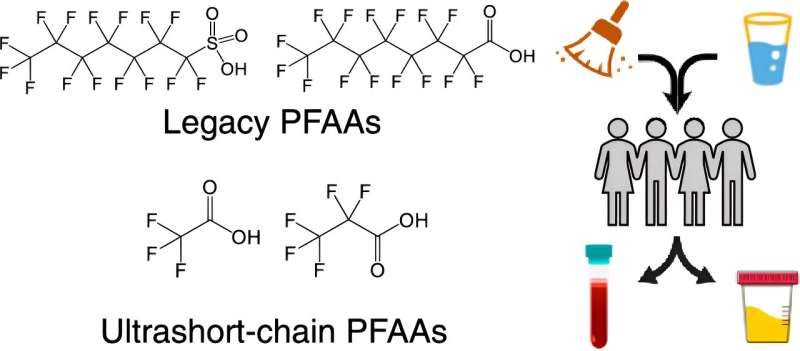This article has been reviewed according to Science X's editorial process and policies. Editors have highlighted the following attributes while ensuring the content's credibility:
fact-checked
peer-reviewed publication
trusted source
proofread
'Ultrashort' PFAS compounds detected in people and their homes

Per- and polyfluoroalkyl substances (PFAS) have become ubiquitous throughout the environment, and increasing evidence has demonstrated their deleterious effects. A group of smaller, fluorinated compounds are becoming replacements for these "forever chemicals," though research suggests the smaller versions could also be harmful.
Now, a study in Environmental Science & Technology reports that the levels of these substances in many indoor and human samples are similar to or higher than those of legacy PFAS.
Though PFAS have seen widespread use in consumer goods, including food packaging, period products and toilet paper, some governments are beginning to regulate their use.
The most common are PFOS and PFOA—each are built with eight-carbon-long backbones and are considered to be perfluoroalkyl acids (PFAAs). "Short-chain" PFAAs, containing fewer than eight carbons, and "ultrashort-chain" PFAAs, with just two to three carbon atoms, have been thought to be suitable replacements for PFOS and PFOA.
However, recent research has shown that their small size makes it easy for them to move throughout water supplies, and in vitro and in vivo tests have suggested that they could be more toxic than the longer compounds. So, Amina Salamova, Guomao Zheng and Stephanie Eick wanted to see if ultrashort PFAAs are accumulating in homes and in human bodies and understand how they might be getting there.
Over 300 samples of dust, drinking water, serum and urine were collected from 81 people and their homes in the U.S., then analyzed for 47 different PFAAs and their precursors. Of these fluorinated compounds, 39 were detected, including ultra-short and short-chain compounds. For instance:
- PFOS and PFOA were frequently detected in dust, drinking water and serum, but were less abundant than the shorter-chain PFAAs.
- In most dust, drinking water and serum samples, two-carbon-long trifluoroacetic acid was the most predominant PFAA, often followed by three-carbon long perfluoropropanoic acid.
- But in urine samples, the 5-carbon long perfluoropentanoic acid was the most abundant PFAA present.
The researchers explain that the smaller PFAAs could slip through filters into drinking water or accumulate easily in household dust. Interestingly, dust samples from homes without carpets and homes that were vacuumed regularly contained substantially lower levels of PFAAs. From the data, the team determined that dust and water intake only contributed only about 20% of the total PFAA burden in these people.
This result suggests that these compounds must primarily originate from other sources—many PFAA precursors can be found in consumer products, and some evidence suggests that they can break down into shorter-chain compounds in the environment or in the body. The researchers say that further investigation into ultra-short PFAA levels, their sources and their effects on human health is needed.
More information: Elevated Levels of Ultrashort- and Short-Chain Perfuoroalkyl Acids in US Homes and People, Environmental Science & Technology (2023). DOI: 10.1021/acs.est.2c06715. pubs.acs.org/doi/abs/10.1021/acs.est.2c06715
Journal information: Environmental Science & Technology
Provided by American Chemical Society





















